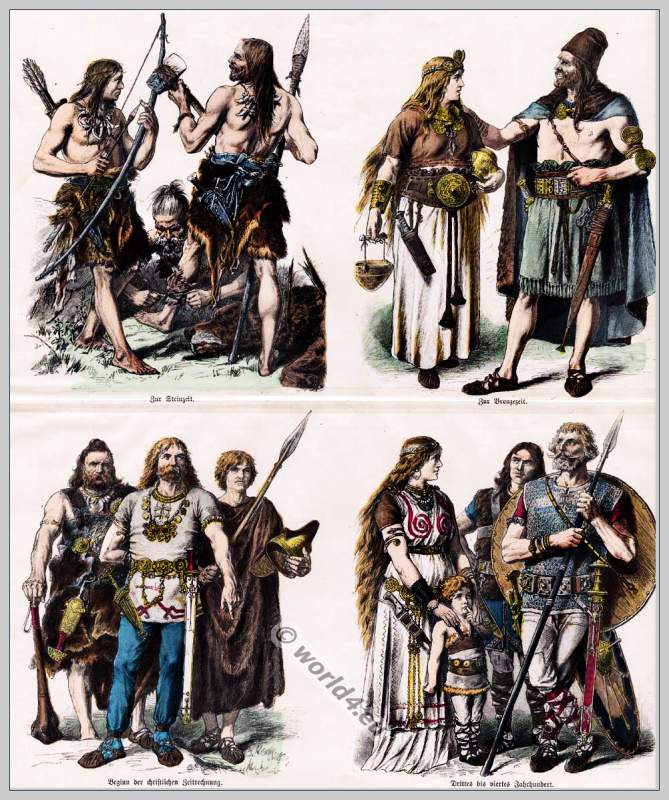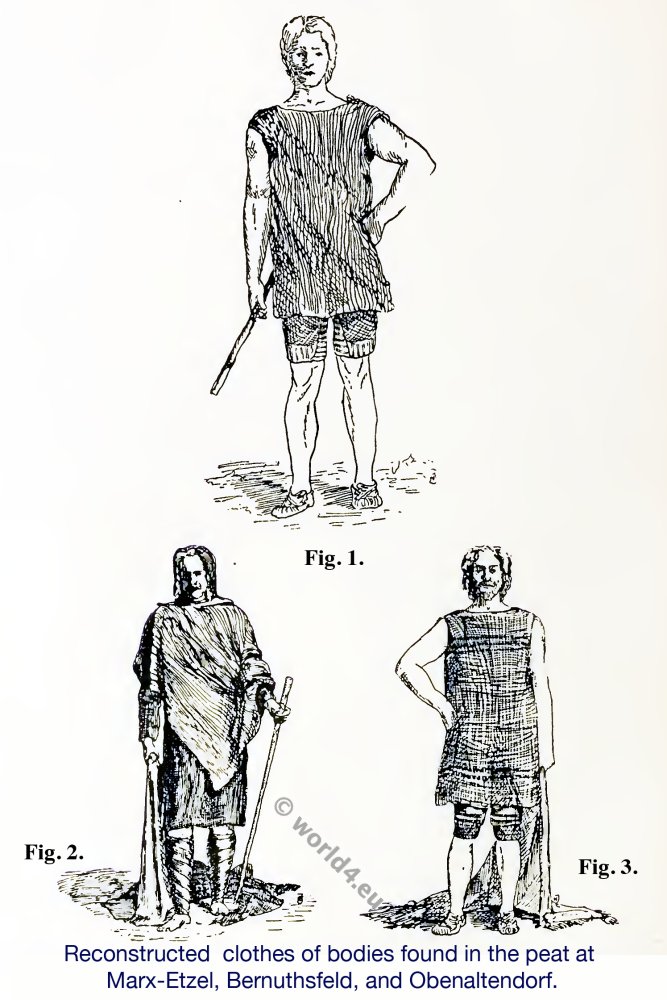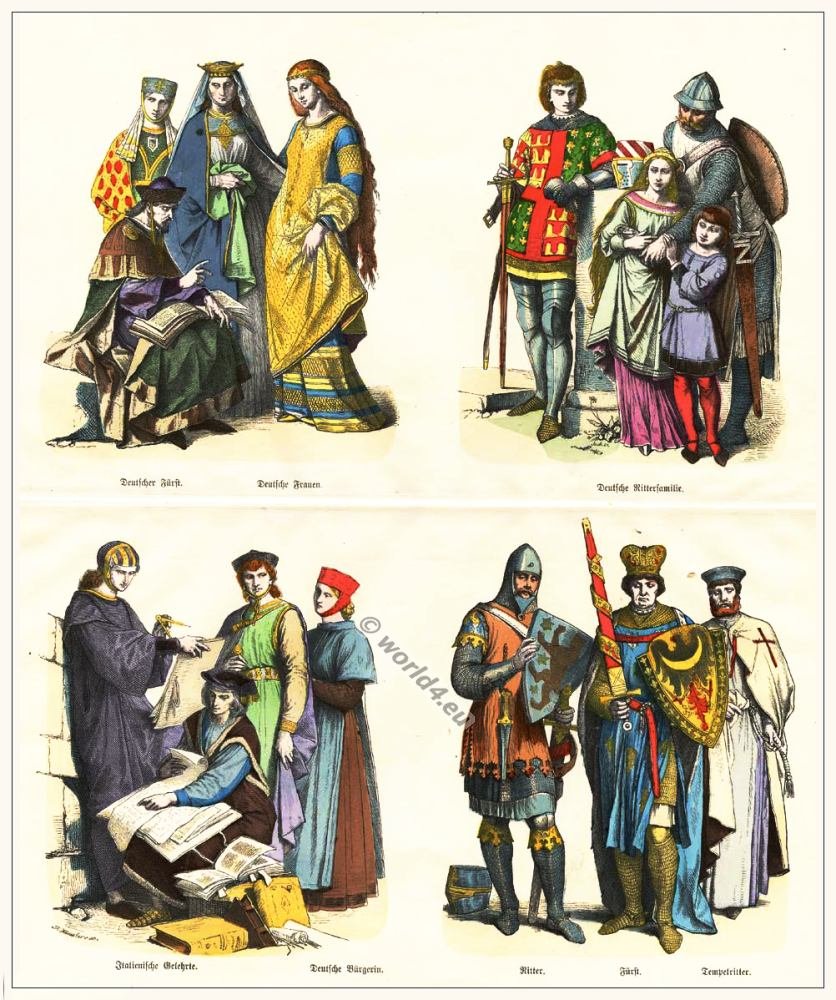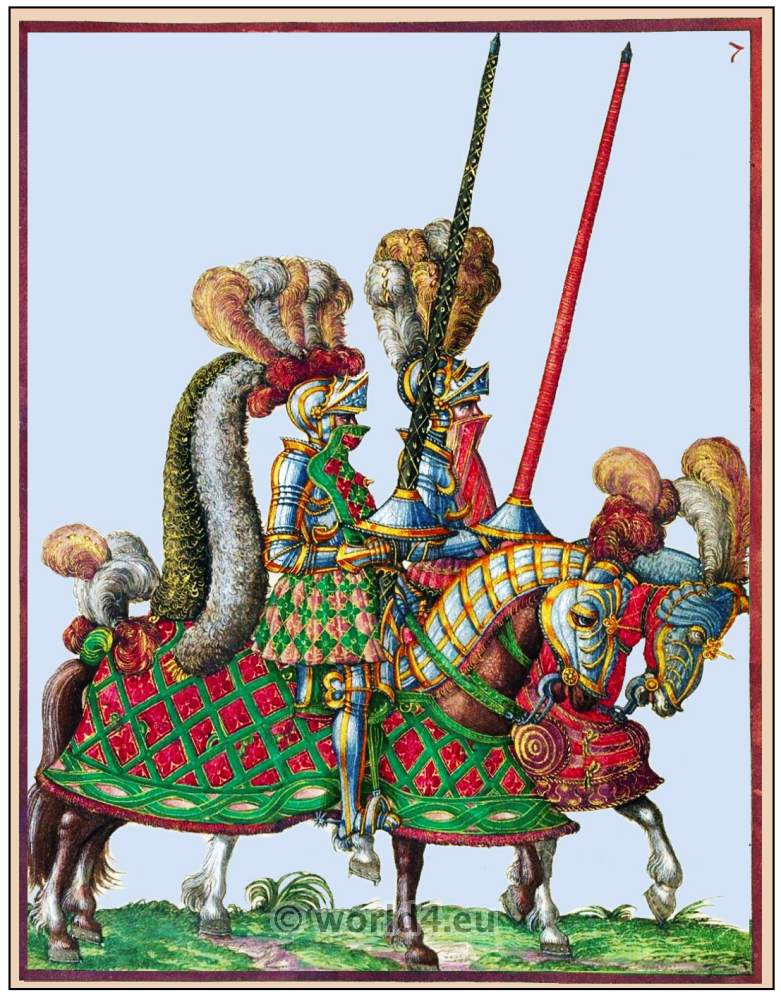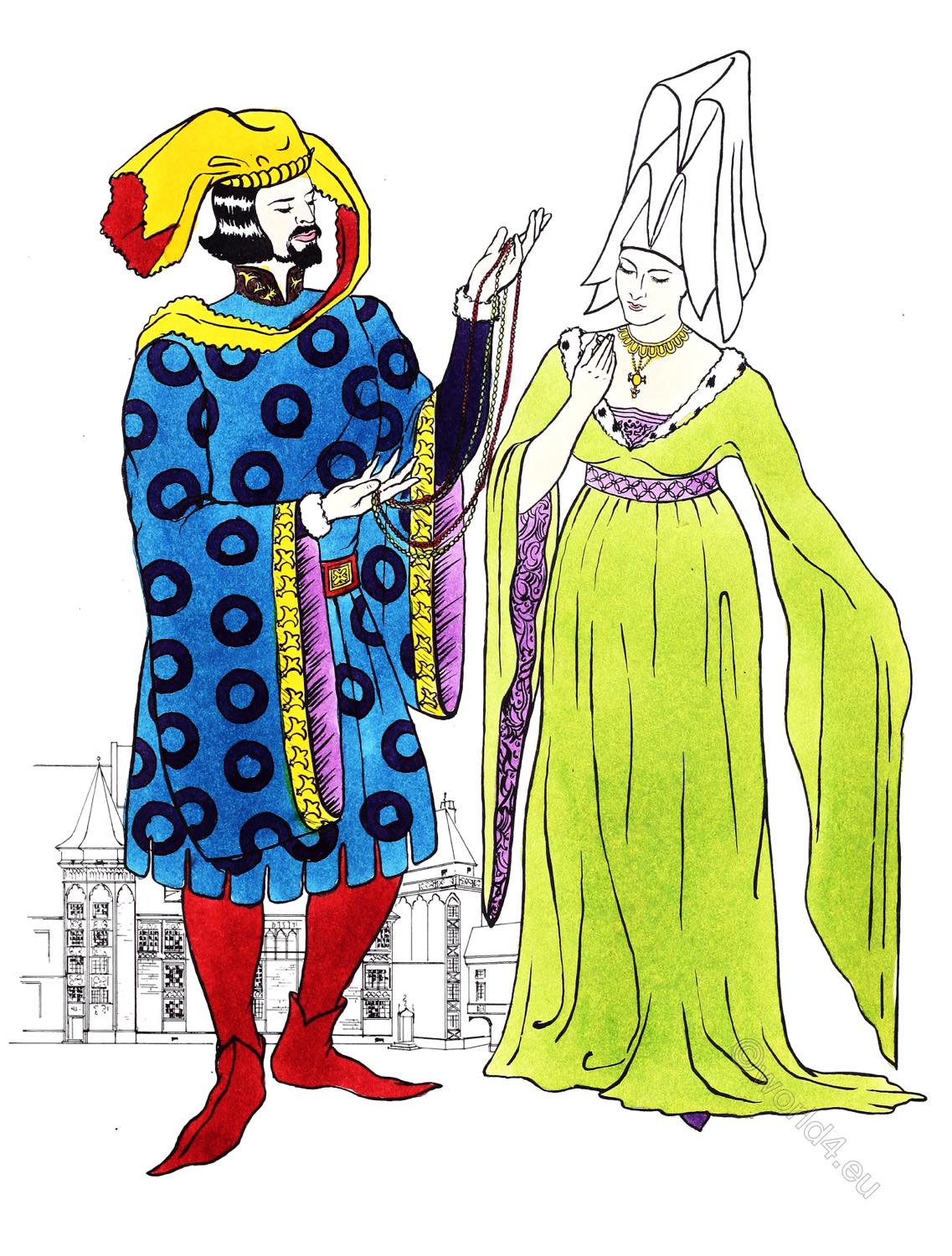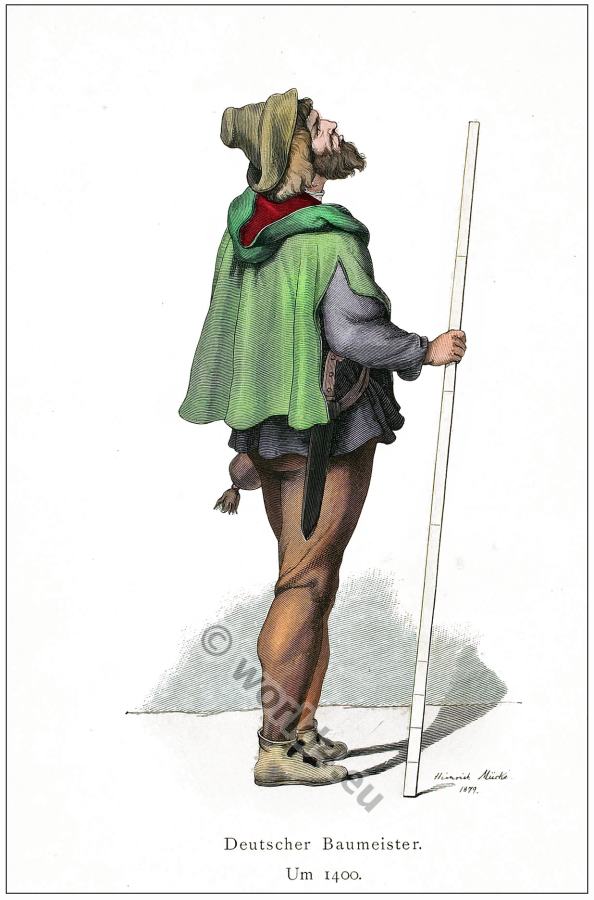Ancient Germans, Teutons clothing.
From the Stone Age to the fourth century.
Top row left: Germanic clothing and weaponry during the Stone Age. Right: Germanic women and men clothing, jewelry and weapons during the Bronze Age.
Bottom row left: Germanic men’s clothing and weaponry at the time of Christ’s birth. Right: Germanic warriors, woman and child clothing in the third and fourth centuries.
Source: On the history of costumes. Münchener Bilderbogen 1848 to 1898.
Teutonic costume prehistoric period, third and fourth centuries A.D.
THE earliest remains of costume from which we gain a faithful picture of the dress of the Teutonic peoples are those on some corpses of the Bronze Age found preserved in peat. We are now able with their help to form some conception of the stage of civilization that succeeded that of the primitive dress of pelts and skins.
The costume of these men of the Bronze Age exhibits the same amazing beauty of form which delights us in their dainty bronze brooches. Long ages of evolution must have gone before the attainment of this style of dress and the development of the material which was used. An equally faithful picture is provided by the numerous discoveries of later corpses belonging to the third and fourth centuries a.d. in peat in North-west Germany, Holland, and Denmark, and we have now a fairly complete idea of the dress current in these countries at the beginning of the early historical period.
The men of the Teutonic tribes
The men of the Teutonic tribes to which these corpses belonged wore short breeches, a smock with or without sleeves, a large plaid which served as a cloak, leg bandages round the knee and shin-bone, and leather footwear like sandals, fastened with laces. (See Figs. 1.,2.,3.,.) The hair above the forehead was kept short, and the same practice was followed with the hair at the back of the head, the moustache, the beard, and the whiskers.
The hair seems to have been ruddy-fair in color. The material used for the garments was presumably dressed hide and leather, and at a later time patterned material made of wool, bast, ticking, and twill cloth, as well as frieze, felt, and, among the Goths, linen. The smocks were plain or striped, and trimmed with braid made from dyed thread.
These shirt-like smocks had an opening at the breast, and came as low as the knee. They were either slipped on over the head or were sewn at one shoulder and fastened at the other with a brooch or clasp. Smocks with long sleeves do not appear till later. The sleeves were sometimes made of other material than that of the body of the garment, and were trimmed with colored braid. With the smock from the second century onward a shirt was worn—first of wool, afterward of linen. The smock was worn either over or under the hose, and in the former case was kept in place by a buckled girdle.
The Teutons wore hose of some kind as far back as the Bronze Age. At first they were long trousers, then knee-breeches and ankle-length breeches, and later still ankle-length breeches with bands which fastened below the knee. Foot-coverings were worn with the knee-breeches. As garters the Teutons used woollen strings or strips of hide (Fig. 2.). Loops were attached to the top of the breeches to hold the girdle in place.
The following are the measurements of breeches from Damendorf: length, 1-15 m.; width, 85 cm.; width of legs at the foot, 28 cm. Those from Thorsberg measured 1-20 m. in length and 1’05 m. in width. In South-west and Central Germany from the first to the fourth century ankle-length breeches were worn. They were made of leather or woollen material—more rarely of ticking. Over these garments was worn a cloak of fur without sleeves, or a woolen cloak closed at the breast. The woolen cloak was usually oval or rectangular, and at a later time square. There were also hooded cloaks, or cloaks with openings for the head like the rough woolen coats of the hill-peasants of Bavaria. The Teutonic footgear even in early times was specially handsome with its numerous latchets and delicate lattice ornamentation.
In the period that immediately followed the migration of nations came the intermingling of the ancient Teutonic civilization with those of the Roman and Byzantine Empires. An ever-increasing fondness for rich-colored materials grew up, especially among the Angles and Saxons, and beautiful trimmings, gay braid, and fringes came into fashion. The treatment of fur became more skill full, and the art of weaving made great progress.
The fastening of garments was now done with the aid of clasps, buckles, ribbons, straps, and girdles. From the earliest times great care was taken with the hair, as is proved by the discovery of razors, combs, and scissors. It was a favorite practice to dye the hair bright red. The Western Teutons wore the hair in a knot at the right side of the head, with the ends hanging down or stiffened so as to project like horns. Among the Northern and Eastern Teutons the hair hung down loose, while the Saxons cut it short. There was no uniform fashion regarding the beard, but the moustache was rare.
Teutonic women
Teutonic women wore a linen garment like a sleeveless shirt, fastened at the shoulder with a brooch and held in by a buckled girdle. A pocket was fastened to the girdle.
We possess little accurate information regarding the dress of Teutonic women. Roman works of art, most of which are purely imaginative and therefore unreliable, are our only sources of information. Most of these garments were made of linen, and this material cannot withstand like wool the effects of burial in bog or earth. The only reliable information we have concerns their jewellery.
We possess a large number of beautiful brooches and buckles of gold and silver set with colored stones. Dainty hair-combs, necklets, armlets, and finger-rings bear witness to the characteristic Teutonic fondness for bright metal ornaments, of which the ancient songs and legends say so much. The expert maker of such objects was held in high respect by these peoples—witness the story of Wayland the Smith. It is only toward the close of the early historic period that we come upon coloured garments, made presumably of textile materials or coloured braids such as were used for men’s dress. The sixth century A.D. brought for the women too the improved wardrobe that was introduced under Roman and Byzantine influence and developed into lavish luxuriousness under the Merovingians.
The cloak was not often worn by women. It was a large wrap, or shawl, drawn over the head and fastened, like the under-garment, by means of a brooch or a clasp. Unmarried women wore the hair loose or encircled by a hoop ; married women gathered it up with the help of combs and hairpins. The southern tribes, Franks and Alemanni, plaited it with ribbons or even with gold thread. Women’s shoes, like the men’s, were of the finest leather work.


